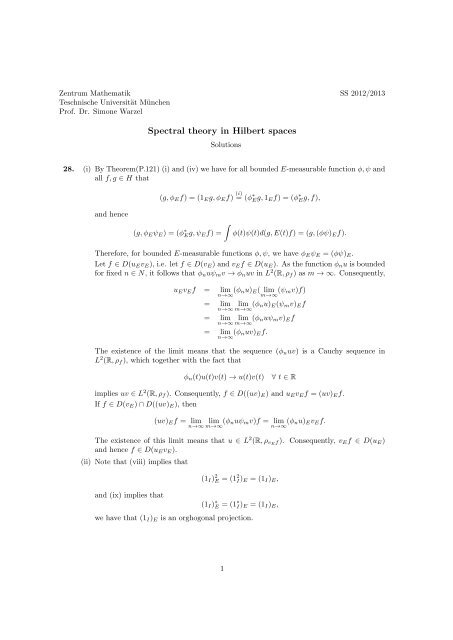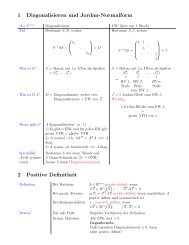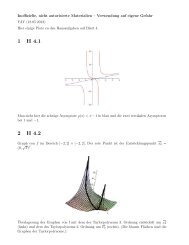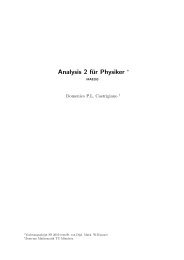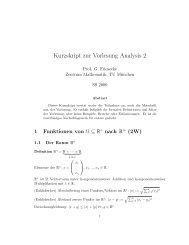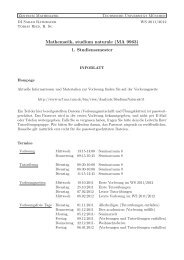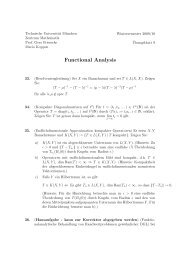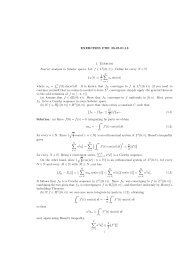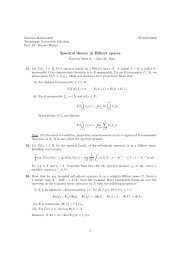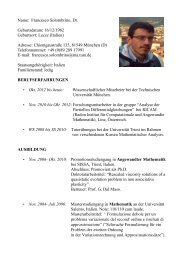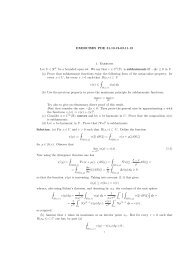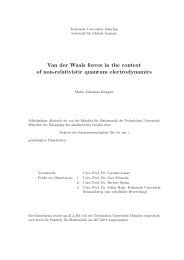Spectral theory in Hilbert spaces
Spectral theory in Hilbert spaces
Spectral theory in Hilbert spaces
You also want an ePaper? Increase the reach of your titles
YUMPU automatically turns print PDFs into web optimized ePapers that Google loves.
Zentrum Mathematik SS 2012/2013<br />
Teschnische Universität München<br />
Prof. Dr. Simone Warzel<br />
<strong>Spectral</strong> <strong>theory</strong> <strong>in</strong> <strong>Hilbert</strong> <strong>spaces</strong><br />
Solutions<br />
28. (i) By Theorem(P.121) (i) and (iv) we have for all bounded E-measurable function ϕ, ψ and<br />
all f, g ∈ H that<br />
(g, ϕ E f) = (1 E g, ϕ E f) (i)<br />
= (ϕ ∗ Eg, 1 E f) = (ϕ ∗ Eg, f),<br />
and hence<br />
∫<br />
(g, ϕ E ψ E ) = (ϕ ∗ Eg, ψ E f) =<br />
ϕ(t)ψ(t)d(g, E(t)f) = (g, (ϕψ) E f).<br />
Therefore, for bounded E-measurable functions ϕ, ψ, we have ϕ E ψ E = (ϕψ) E .<br />
Let f ∈ D(u E v E ), i.e. let f ∈ D(v E ) and v E f ∈ D(u E ). As the function ϕ n u is bounded<br />
for fixed n ∈ N, it follows that ϕ n uψ m v → ϕ n uv <strong>in</strong> L 2 (R, ρ f ) as m → ∞. Consequently,<br />
u E v E f = lim (ϕ nu) E ( lim (ψ mv)f)<br />
n→∞ m→∞<br />
= lim lim (ϕ nu) E (ψ m v) E f<br />
n→∞ m→∞<br />
= lim lim (ϕ nuψ m v) E f<br />
n→∞ m→∞<br />
= lim (ϕ nuv) E f.<br />
n→∞<br />
The existence of the limit means that the sequence (ϕ n uv) is a Cauchy sequence <strong>in</strong><br />
L 2 (R, ρ f ), which together with the fact that<br />
ϕ n (t)u(t)v(t) → u(t)v(t)<br />
∀ t ∈ R<br />
implies uv ∈ L 2 (R, ρ f ). Consequently, f ∈ D((uv) E ) and u E v E f = (uv) E f.<br />
If f ∈ D(v E ) ∩ D((uv) E ), then<br />
(uv) E f = lim<br />
n→∞<br />
lim (ϕ nuψ m v)f = lim (ϕ nu) E v E f.<br />
m→∞ n→∞<br />
The existence of this limit means that u ∈ L 2 (R, ρ vE f ). Consequently, v E f ∈ D(u E )<br />
and hence f ∈ D(u E v E ).<br />
(ii) Note that (viii) implies that<br />
and (ix) implies that<br />
(1 I ) 2 E = (1 2 I) E = (1 I ) E ,<br />
(1 I ) ∗ E = (1 ∗ I) E = (1 I ) E ,<br />
we have that (1 I ) E is an orghogonal projection.<br />
1
29. We obta<strong>in</strong> by a direct calculation that<br />
− 1 ∮<br />
1<br />
(y,<br />
2πi Γ A − z x)dz<br />
P.121(vi)<br />
= − 1<br />
2πi<br />
∫ ∮<br />
= (<br />
which completes the proof.<br />
Cauchy <strong>in</strong>tegral<br />
=<br />
a,b/∈σ(A)<br />
R<br />
∫ b<br />
a<br />
Γ<br />
∮<br />
Γ<br />
∫<br />
R<br />
1<br />
d(y, E(t)x)dz<br />
t − z<br />
1<br />
dz)d(y, E(t)x)<br />
z − t<br />
1d(y, E(t)x)<br />
= (y, (E(b) − E(a))x),<br />
30. Us<strong>in</strong>g Theorem(P.129), we see that the limit is noth<strong>in</strong>g but 2πi(y, E(t)x). S<strong>in</strong>ce A is a selfadjo<strong>in</strong>t<br />
compact operator, we have<br />
⎧ ∑<br />
P ⎪⎨<br />
j t < 0,<br />
j:λ<br />
E(t) = 2πi<br />
j ≤t<br />
⎪⎩<br />
P 0 + ∑<br />
P j t ≥ 0,<br />
and hence (y, E(t)x) = 2πi ∑<br />
j:λ j ≤t<br />
(y, P j x).<br />
j:λ j≤t<br />
2


